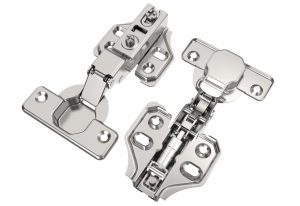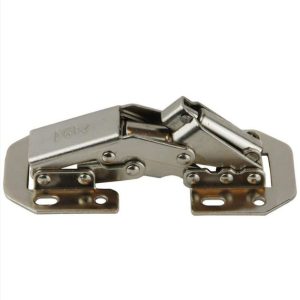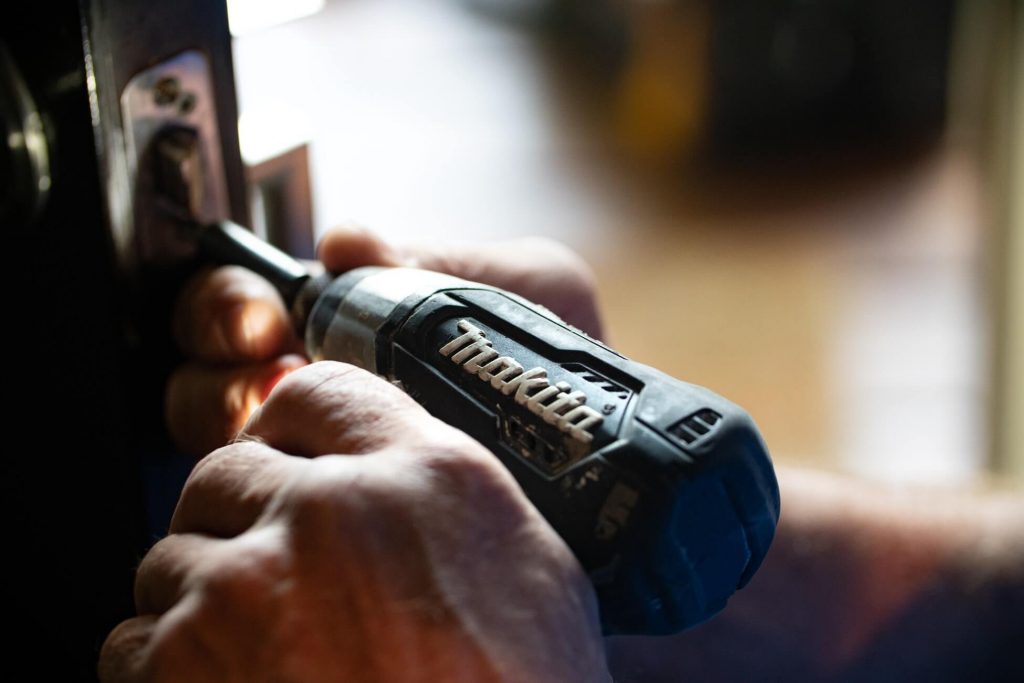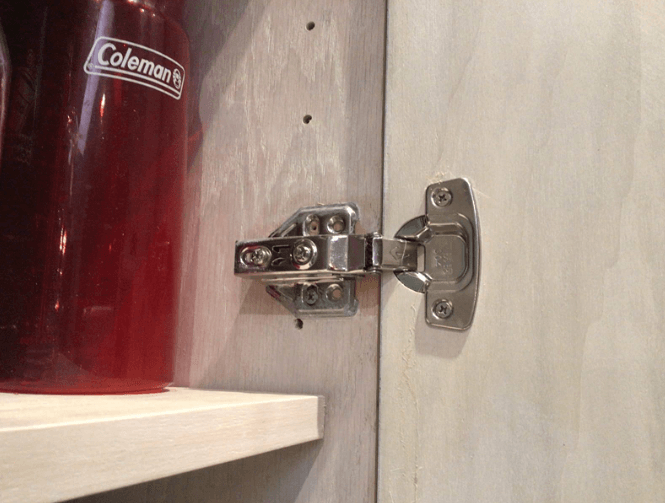Soft-close cabinets have become a crucial element in kitchen design. It provides an excellent solution for quiet and gentle closure of cabinet doors. The innovative soft-close hinge is designed to ensure that cabinet doors close softly, preventing loud and disruptive noises. However, you may encounter issues, such as doors closing too quickly or too slowly. In this comprehensive guide, we will take you through the steps to adjust the speed of soft-close hinges, ensuring a noise-free and customized experience.
Understanding Soft Close Hinges
Soft close hinges come in two types: insert and surface-mounted. To adjust insert-mounted hinges, gently push the lever and tab with enough pressure.
Before adjusting the soft close hinge speed, identify the hinge type in your closet, and ensure it’s positioned sideways. By applying pressure in this position, you can simultaneously adjust both pressure and tension, guaranteeing a smooth closing process.
insert mounted hinge surface mounted hinge
Adjusting Soft Close Hinge Speed
Medium Hinge Setting: If your soft close door requires adjustment, turn and adjust the lever clockwise, pointing it towards the ceiling.
Ensure there is a 10-millimeter gap between the tab and hinges during the adjustment. Experiment with force to achieve the desired speed.
Calibrating Cabinet Doors: Rotate the adjustment lever 90 degrees clockwise, directing the hinge towards the floor. Open and close the cabinet door multiple times to check the soft close hinge adjustment. Experiment to set the ideal speed for each cabinet door and drawer.
Normal Soft Close Hinge Adjustment
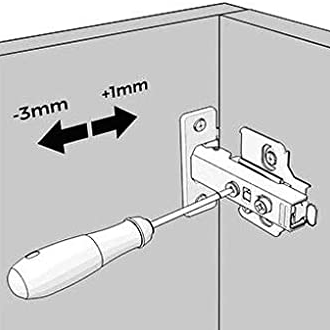
Lateral adjustment

Front to back adjustment
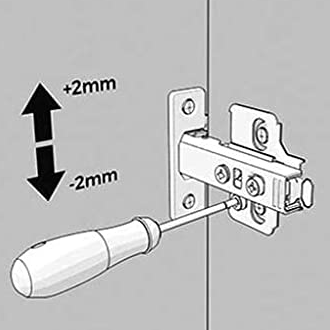
Vertical adjustment
Frequently Asked Questions
Can I Adjust Soft Close Doors and Drawers?
Yes, you can adjust soft close doors and drawers for optimal performance. It’s crucial to ensure proper installation, and any problems may result from improper fitting or obstructions. Check the squareness in drawers and address any issues affecting the closing process.
How Long Does the Adjustment Process Take?
Adapting a soft close hinge involves a detailed process, and the duration varies based on the hinge type. Typically, this adjustment is relatively straightforward, taking around 10 minutes or less.
Yet, if detailed adjustments are required, such as resetting door height or replacing worn-out components, the process may take longer.
Recognize that errors may occur, especially for those unfamiliar with diverse hardware components or lacking knowledge of their interplay. To reduce the risk of mistakes, enlist the help of seasoned professionals well-versed in this hardware, saving time and energy during the entire adjustment procedure.
How to Clean the Soft Close Hinge?
To ensure the longevity of a soft close hinge, proper maintenance is essential. Follow these steps for effective cleaning:
- Use a vacuum cleaner or a small brush attachment to remove debris.
- Gently clean the hinge surface with warm water and mild soap.
- Thoroughly dry the hinges using a cloth or paper towel.
- Apply lubricant sparingly to prevent over-oiling and potential material damage.
Choose non-abrasive cleaners when cleaning to prevent scratching delicate finishes. An old toothbrush works well for tough spots, but use caution with chrome or brass.Avoid harsh chemicals like ammonia or bleach, as they can corrode the hinge surfaces over time. Regular maintenance ensures soft close hinges retain lasting performance.
Are Soft Close Hinges Compatible with All Cabinets?
Soft close hinges, known for their smooth and silent operation, are suitable for most cabinet doors.
During installation, they might require adjustments to ensure a proper fit within the cabinet frame. Carefully follow instructions, as some hinges may necessitate additional screws or brackets for a secure fit.
Overall, soft close hinges provide a cost-effective and easy-to-install solution for most cabinets. With occasional adjustments and proper maintenance, they provide reliable performance over the years.
Is Professional Assistance Necessary for the Adjustment Process?
Adjusting a soft close hinge can be daunting for homeowners.
You don’t need specialized tools, but having a good understanding of hinge mechanics is crucial for making correct and safe adjustments.Consider consulting or hiring a professional if uncertainty exists regarding one’s ability to complete the task accurately.\
Before making adjustments, make sure you have all the necessary materials and follow the manufacturer’s instructions. While general steps apply to most hinges, adhering to specific instructions is vital for safety. If special circumstances, such as door thickness or cabinet material, require alterations, it is advisable to consult with an experienced professional.
What Safety Measures Should I Take During Adjustment?
Before adjusting a soft close hinge, prioritize safety precautions. Wear protective gear such as goggles or gloves to reduce the risk of injury when handling tools or parts. Disconnect power sources connected to the door, such as electricity, water, or gas lines if applicable. Having a second person nearby for assistance and ensuring ample lighting are additional safety measures for accurate work and to prevent errors due to poor visibility.
In summary, it is crucial to take appropriate safety precautions before adjusting a soft close hinge to ensure successful completion of the task without causing harm or property damage. To maintain safety throughout this project, wear protective gear, turn off power sources, have assistance from another person, and ensure proper lighting. These steps are essential for keeping everyone safe during the adjustment process.
Necessary Tips
- Determine the time it takes for a door to open fully.
- Observe the soft close hinge’s original setting.
- Multiply the original setting by the adjustment factor to achieve a slower speed if desired.
Major Concerns
Consider the operation and visual alignment of soft close hinges. Proper installation is vital for a visually appealing kitchen. Misalignment can be noticeable and spoil the aesthetic of your kitchen.
If misalignment occurs, assess whether repairs or replacements are needed, particularly for older hinges.
Using a Screwdriver
If kitchen cabinet doors are misaligned or not closing properly, use a screwdriver to reattach and reinstall them. This simple tool can help you realign and secure cabinet doors effortlessly.
Modifying the Hinge
Use a screwdriver to push the adjustment lever or tab, making sure it is completely retracted. For lever mechanism tools, face it towards the cabinet wall, maintaining a gap between the hinges and the tab. This adjustment ensures smooth door operation without any hassle.
By following these detailed steps and addressing potential concerns, you can understand how to adjust the speed of soft close hinges, optimizing the performance of your kitchen cabinets for a quiet and smooth experience.

